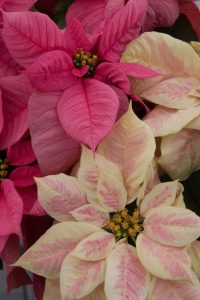Originally published in Panama City News Herald, Extension Connection
November 2020
by Julie McConnell
Like many people I enjoy decorating my home for the holidays and, although I’m a diehard “plant person”, poinsettias did not always rank high on my list. As a new homeowner many years ago, I tried growing them a few times, but they broke easily and died quickly in my

care. While pursuing my B.S. in Horticulture I had virtually sworn off of them when I learned that our Greenhouse Management class project at Auburn University would involve growing hundreds of poinsettias. I was less than thrilled with the prospect.
I learned a lot about commercial production and keeping poinsettias alive that semester, but I also gained an appreciation for this popular plant. Before this endeavor I had only seen traditional red poinsettias, but soon I was introduced to a variety of colors, shapes,
and textures. Many people mistake the colorful portion of poinsettias for the flowers, but the flowers are very small and nearly insignificant. The colorful structures surrounding the tiny flowers are modified leaves called bracts. Bracts may be smooth or ruffled, white, pink, peach, cream, dark red, bright red, or marbled – the possibilities seem endless!

To care for poinsettias in the home, place in a brightly lit room where temperatures will not fall below 65 degrees. Keep them away from drafts or drying air flow such as heating vents. Allow the soil to dry at the surface before watering. As with any plant, be sure the pot it came in has drain holes so that the roots do not remain saturated and rot. The plants are quite brittle and exude a milky sap that may irritate people with latex allergies, so take care when handling if you are sensitive.
In some parts of Florida poinsettias can be grown outdoors, and in the panhandle, you may be able to get away with that if you have a sheltered area of your landscape and are willing to protect plants during cold snaps.
Poinsettias are “short day” blooming plants, which means they need extended periods of darkness to trigger flowering. If you want to keep your plants for many years (either indoors or in the landscape), be sure you will be able to shield them from light at night starting around October 1st until they flower. Even short interruptions in darkness can delay or prevent flowering.
For more information about poinsettias and other holiday plants, make plans to join us on our last Gardening in the Panhandle LIVE! broadcast set for Thursday, November 12th at noon. For details about how to join using Zoom or Facebook, please visit https://nwdistrict.ifas.ufl.edu/hort/
Are you going to be in the Gainesville area December 7-11, 2020? Book an appointment to shop the UF Environmental Horticulture Club Annual Poinsettia Sale! https://sites.google.com/site/ufhortclub/poinsettia-sale
 0
0
